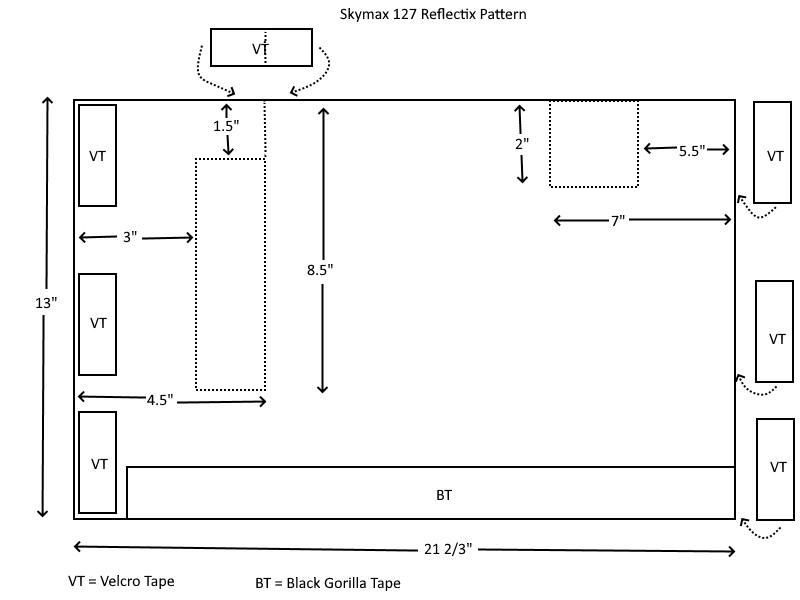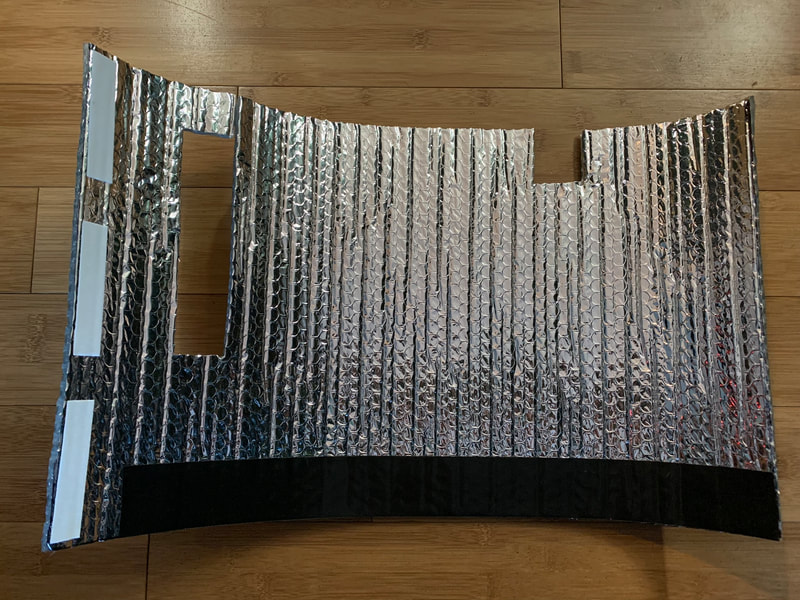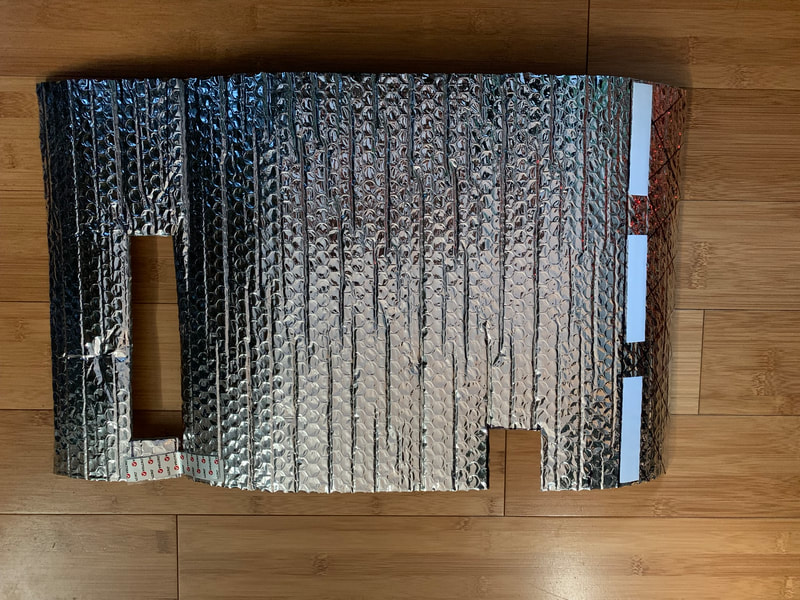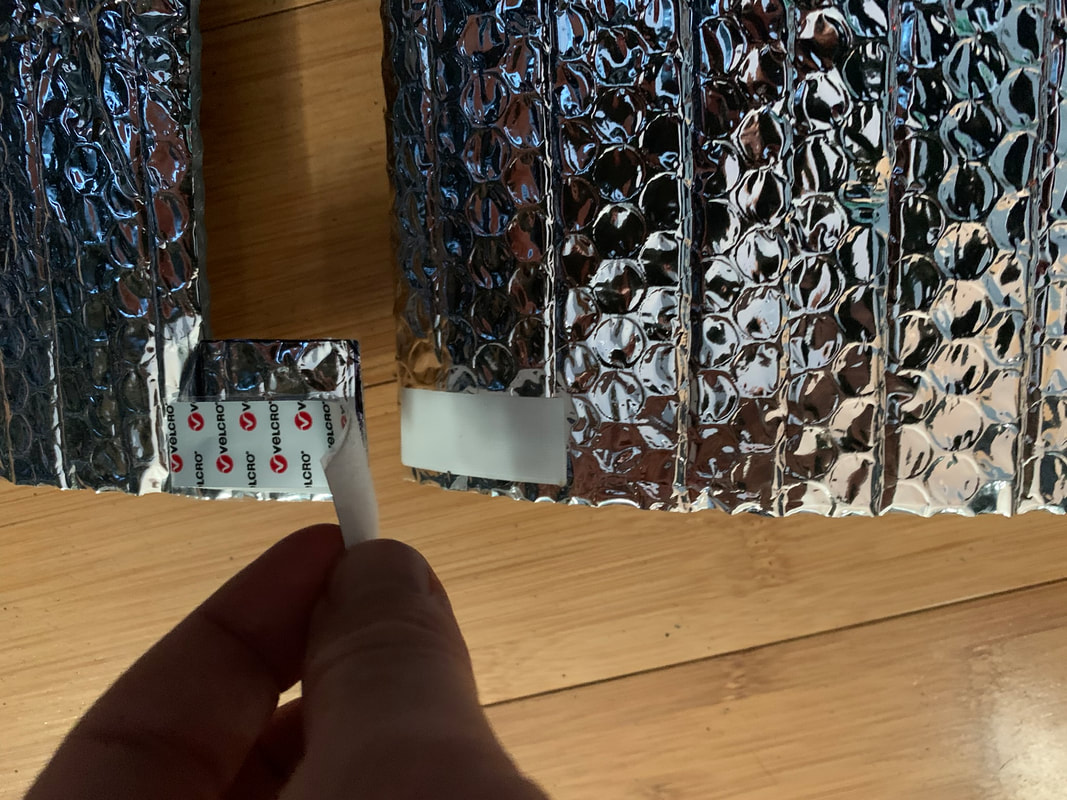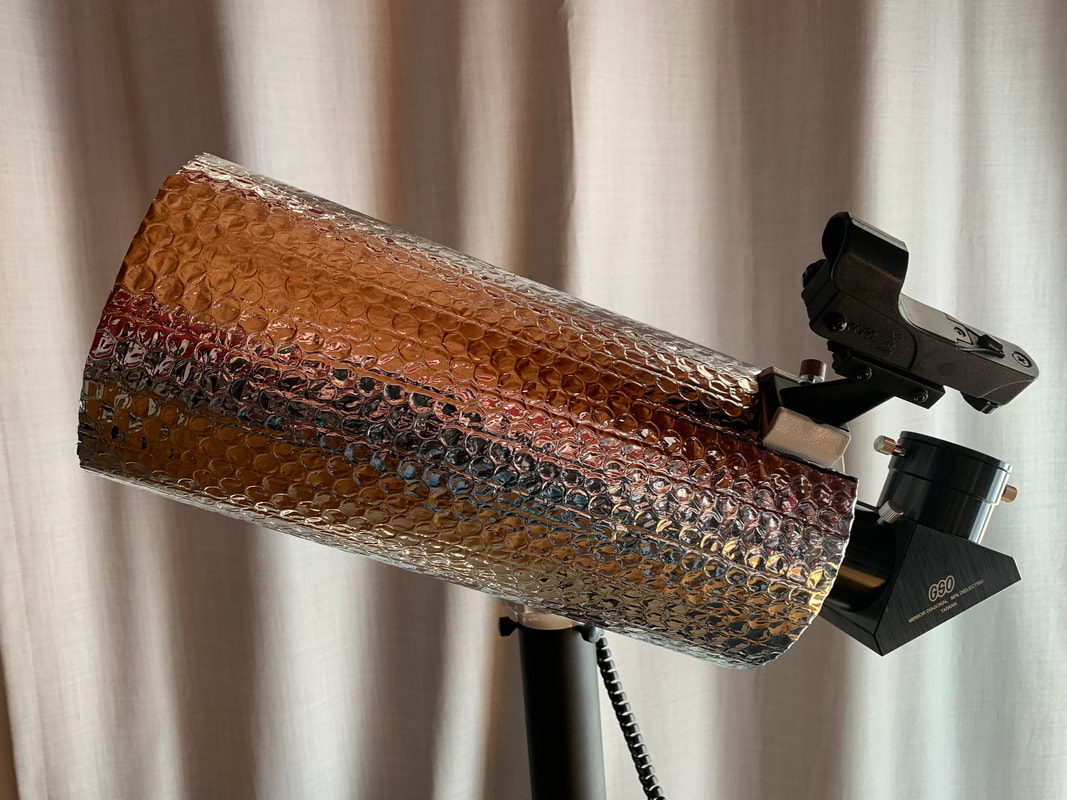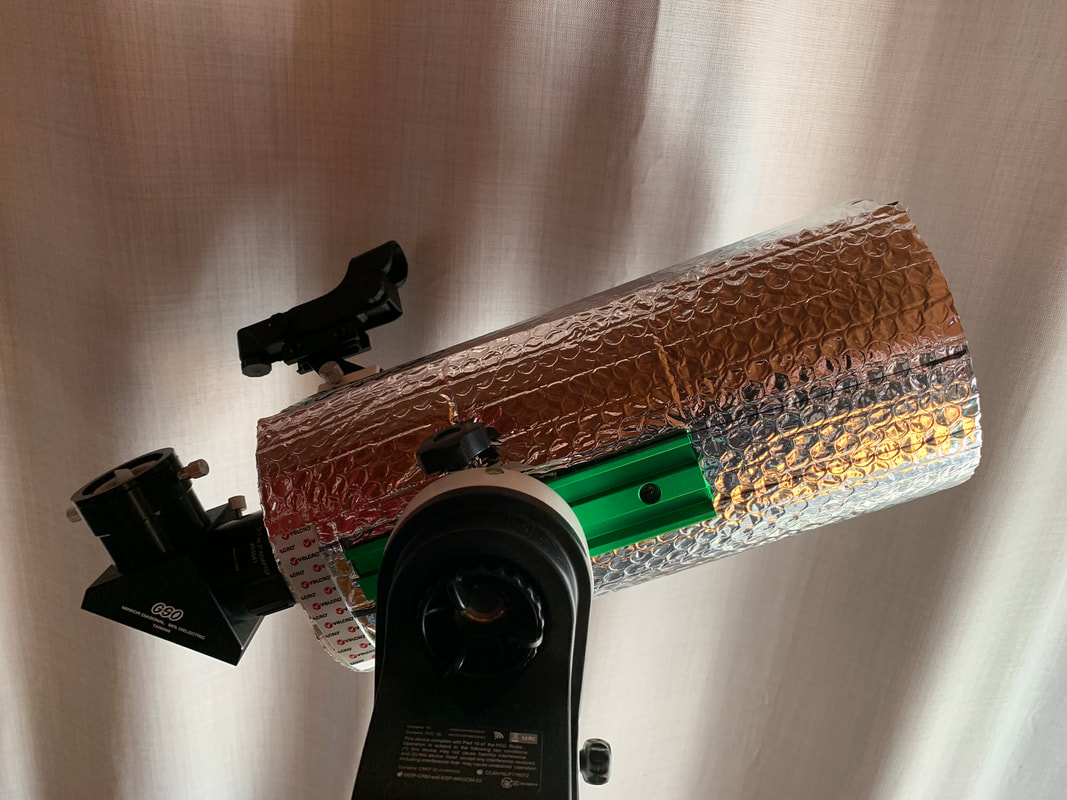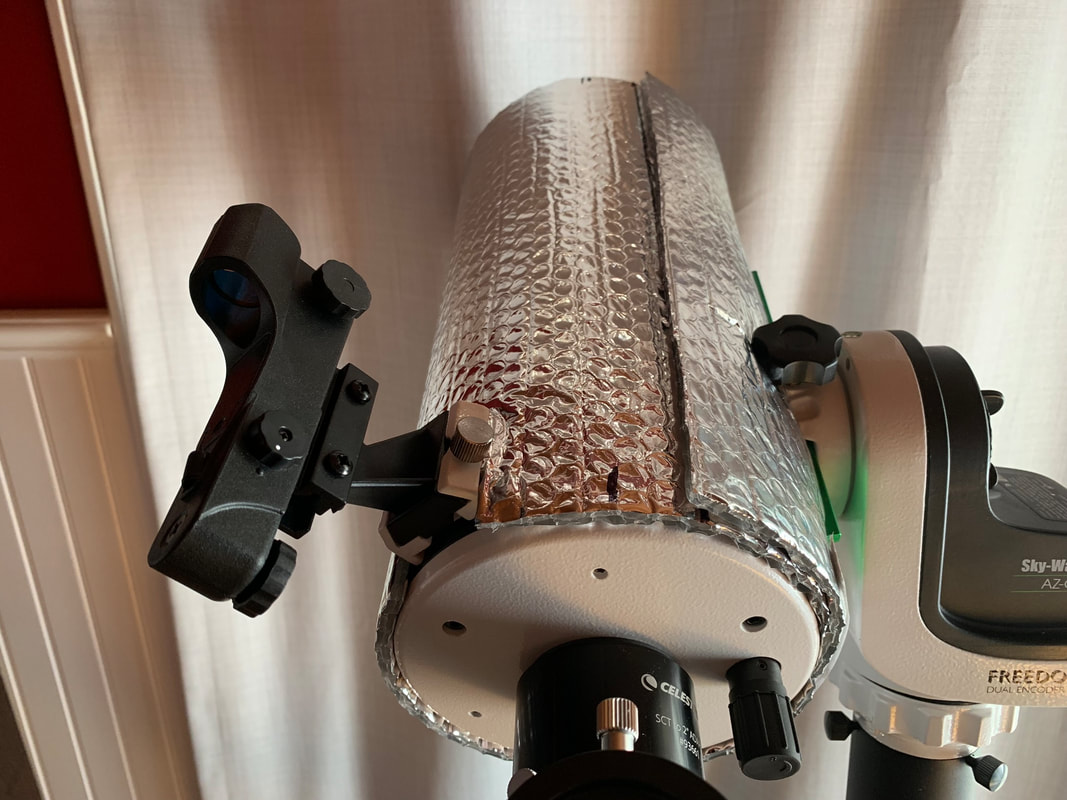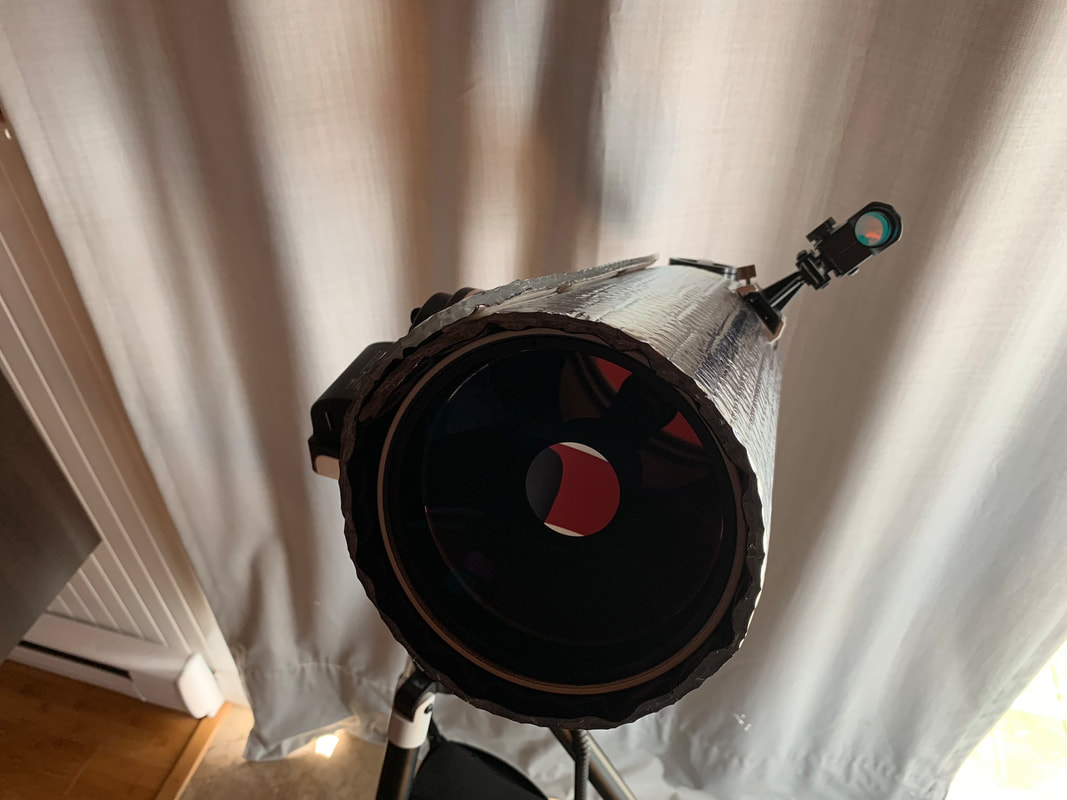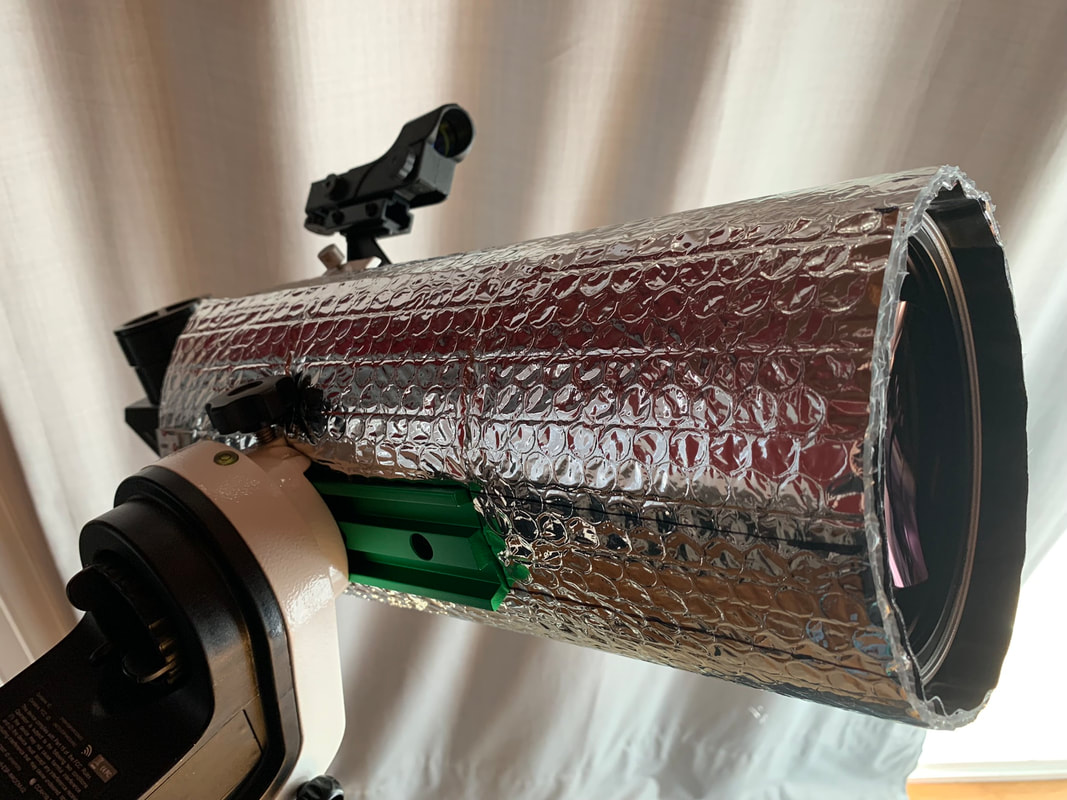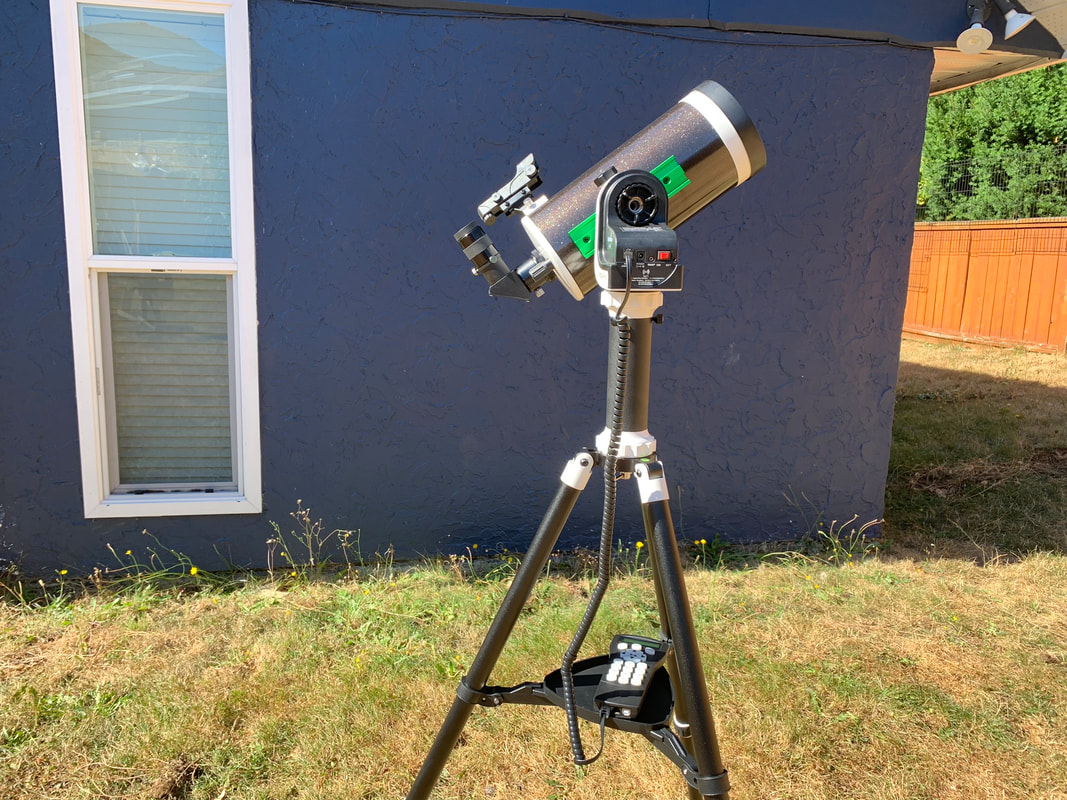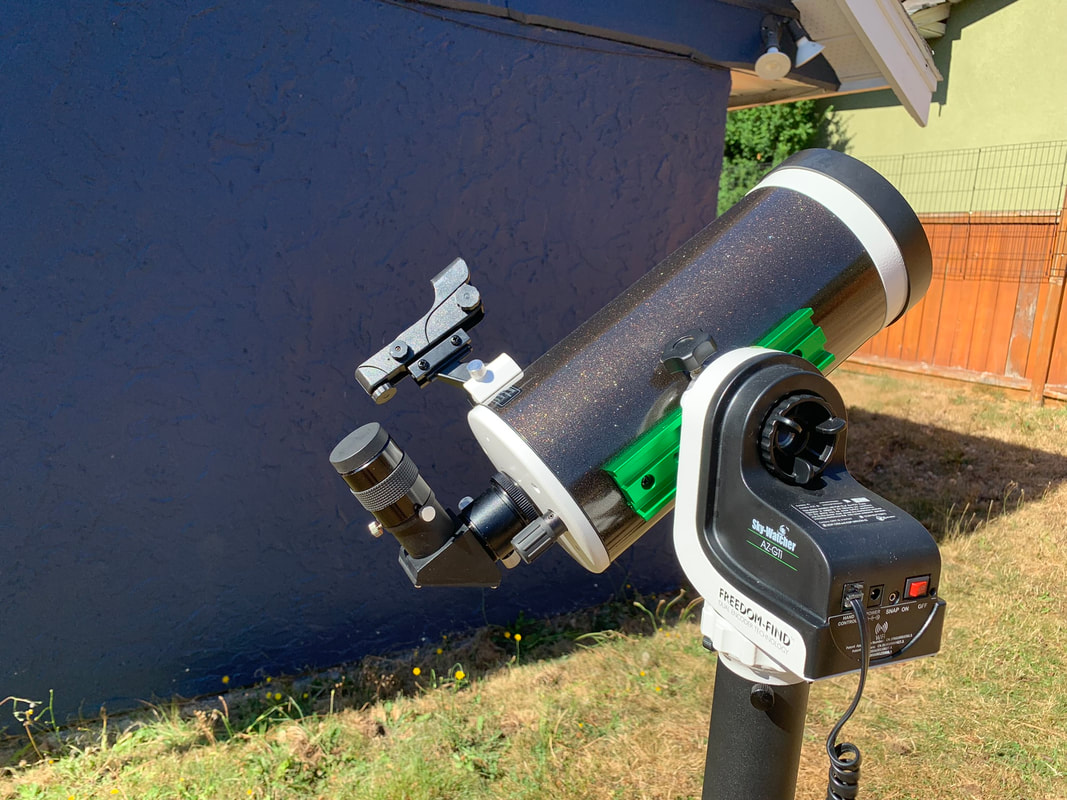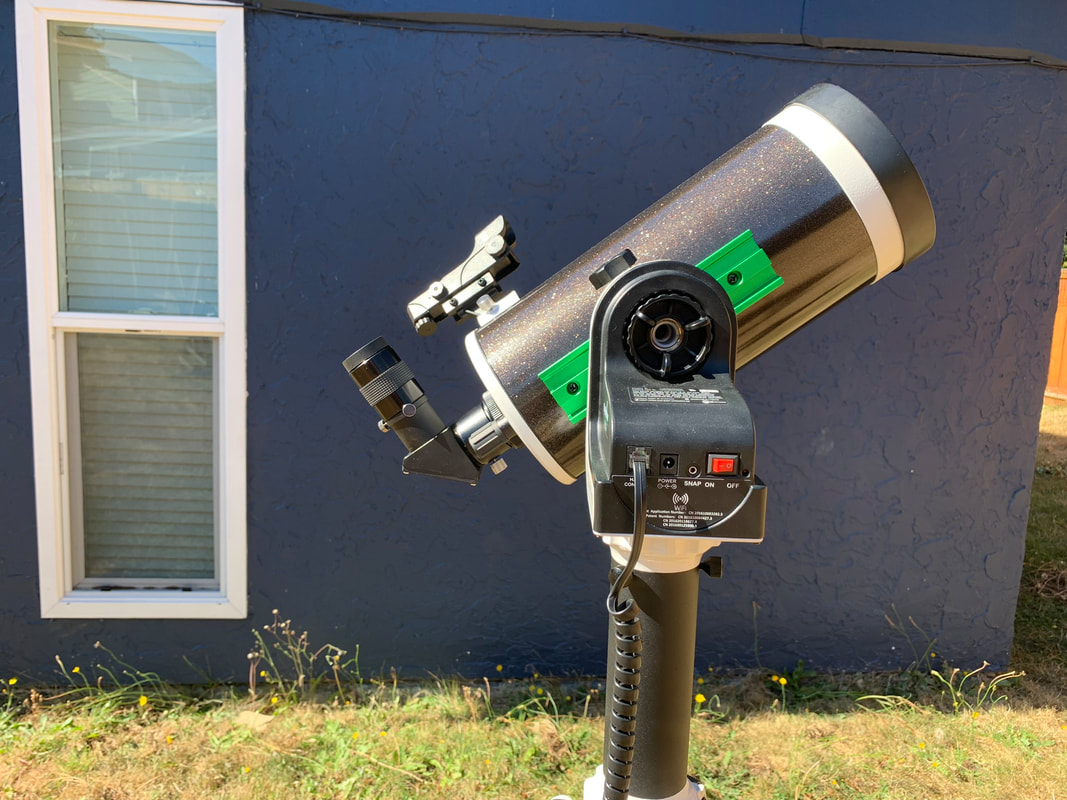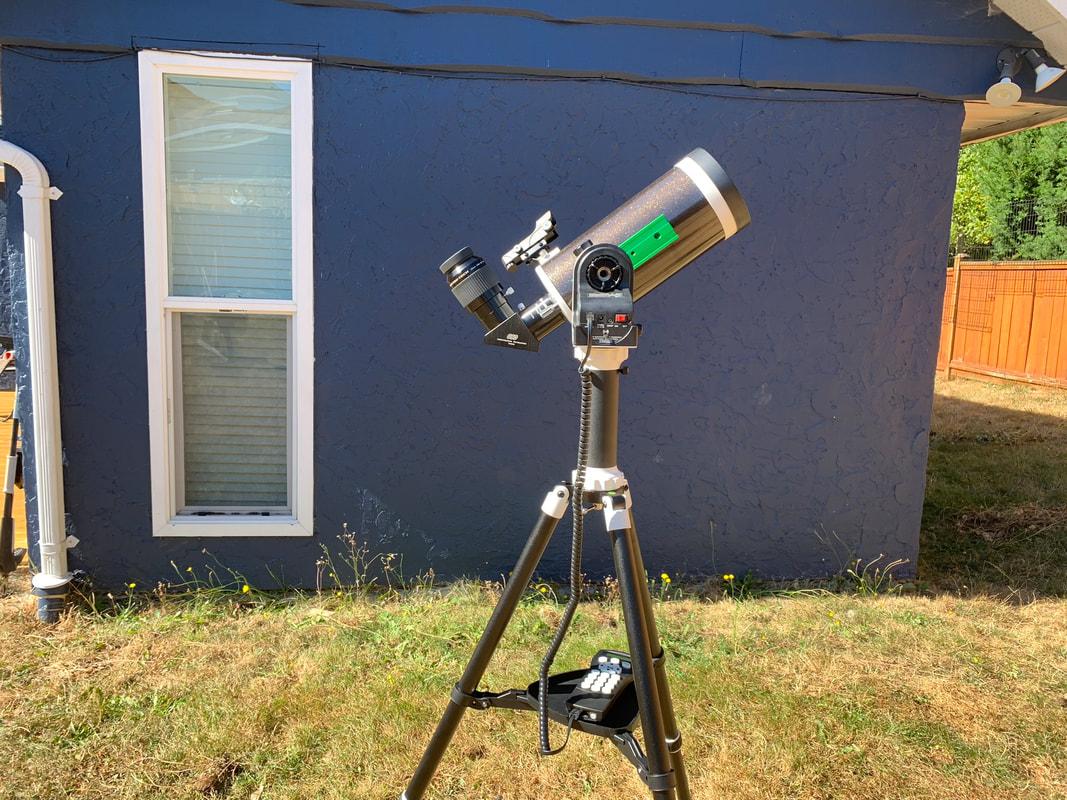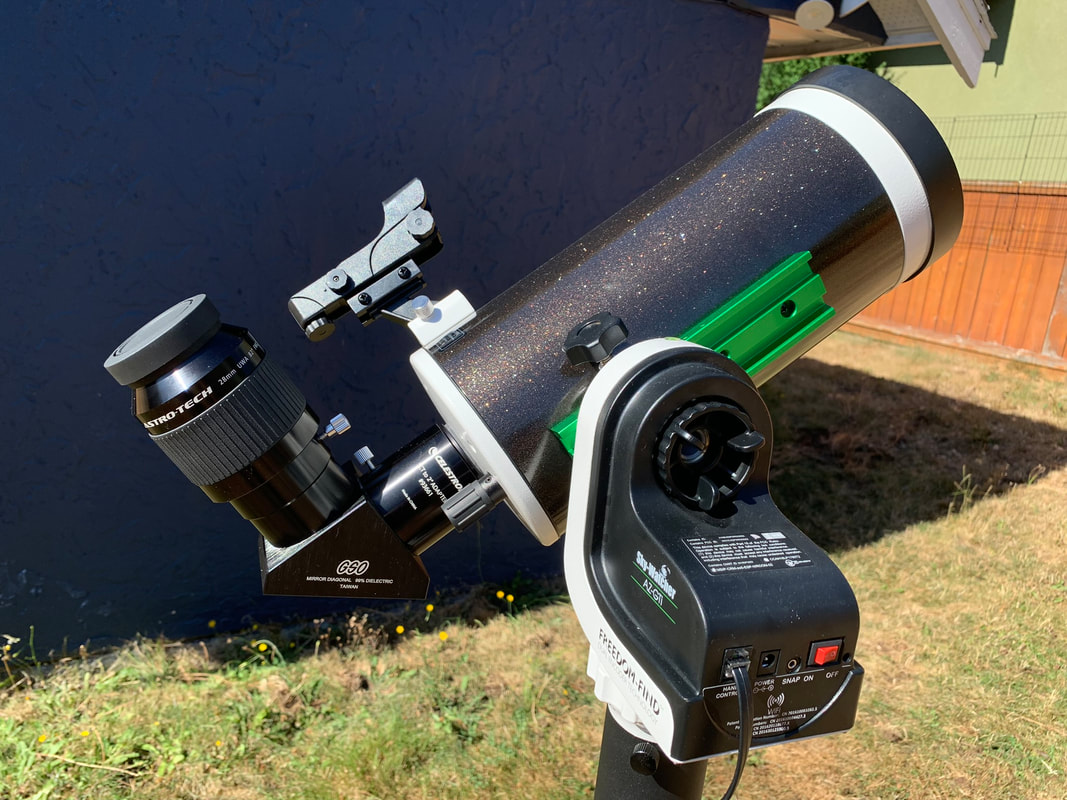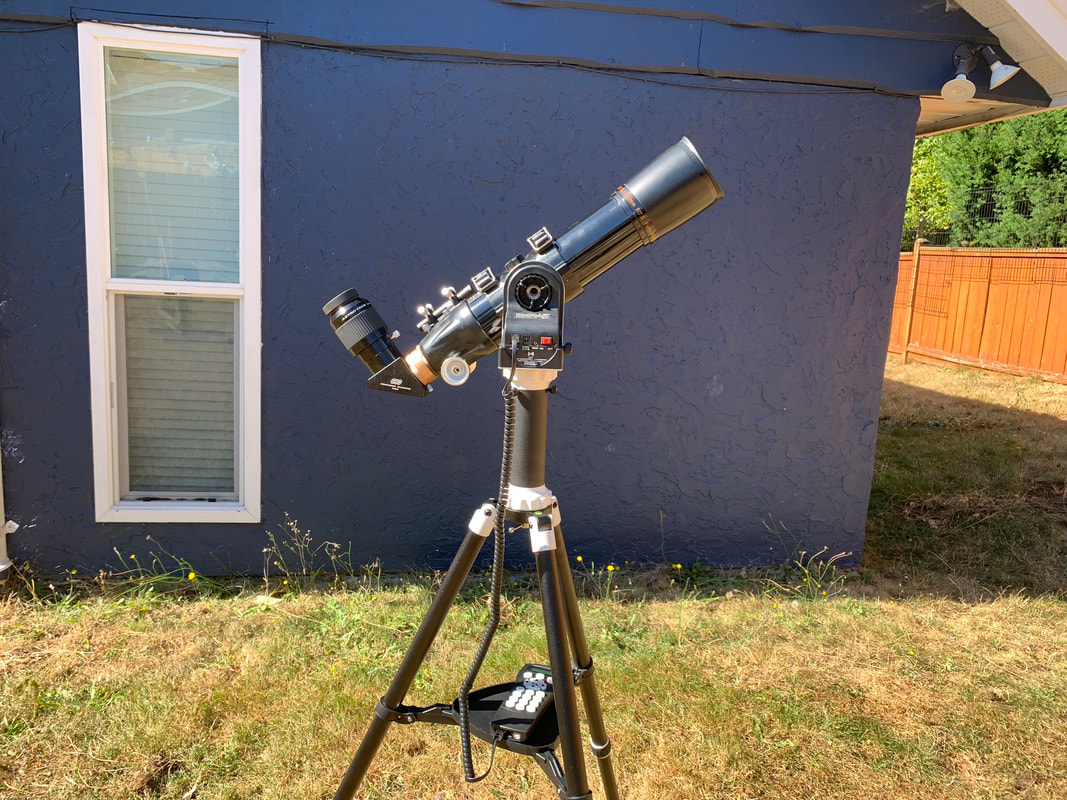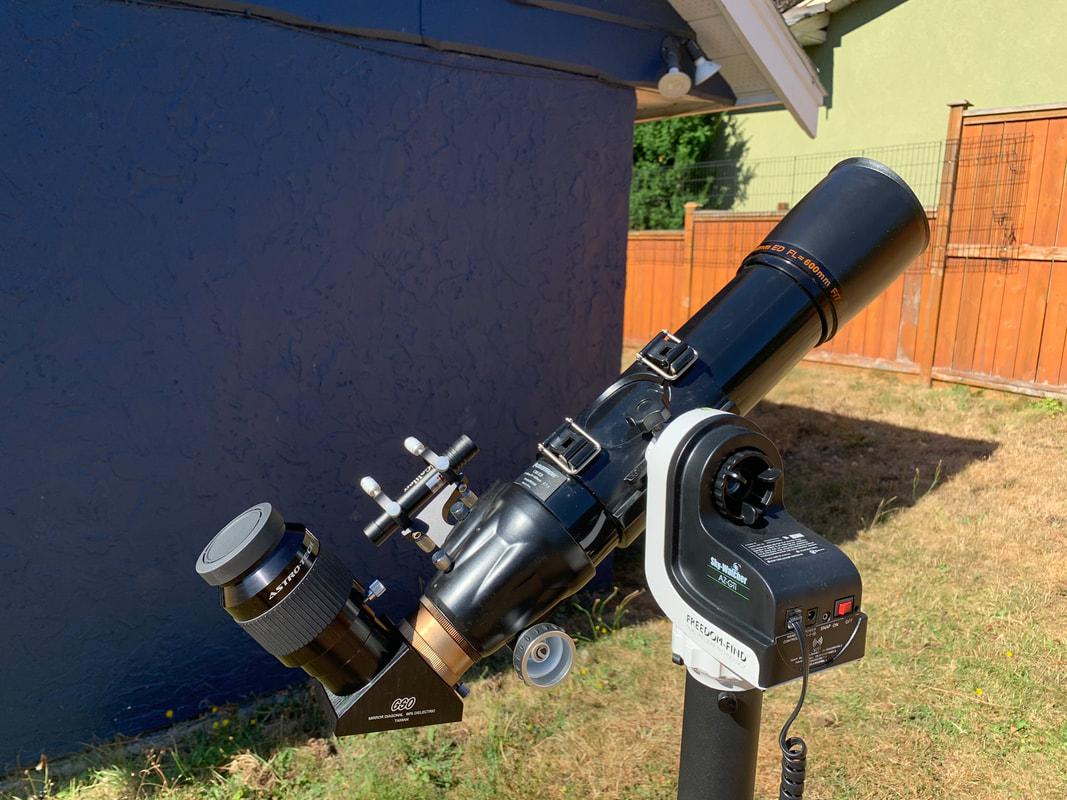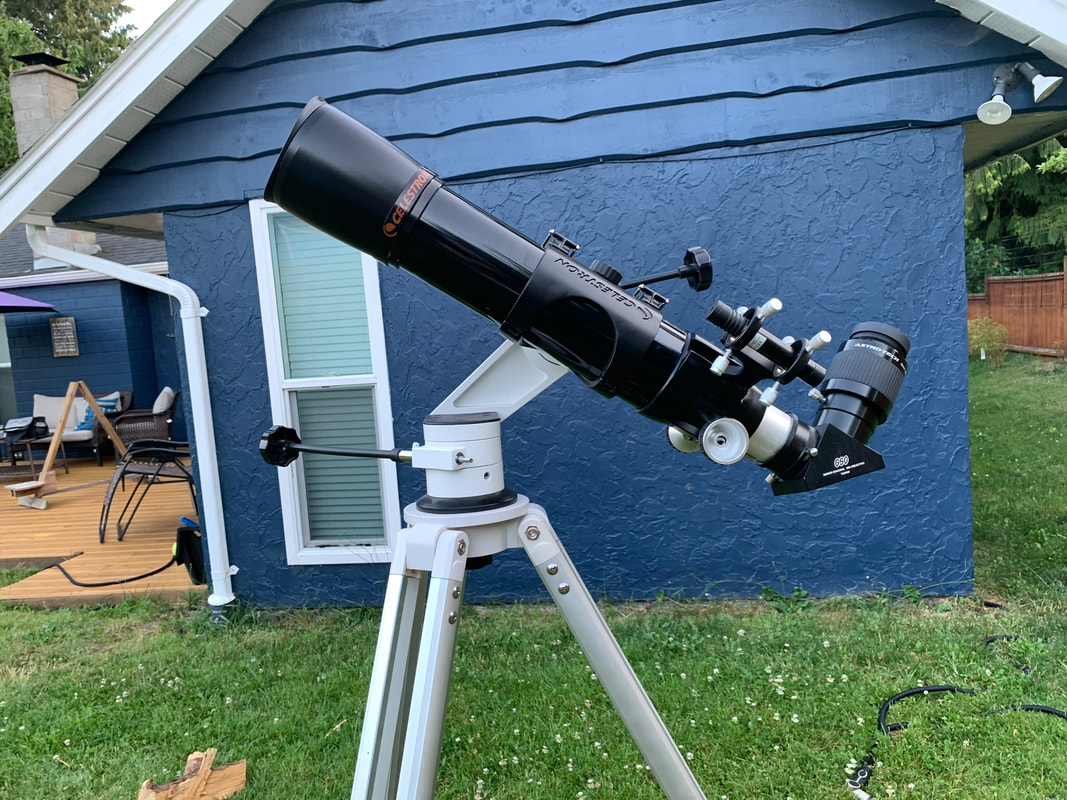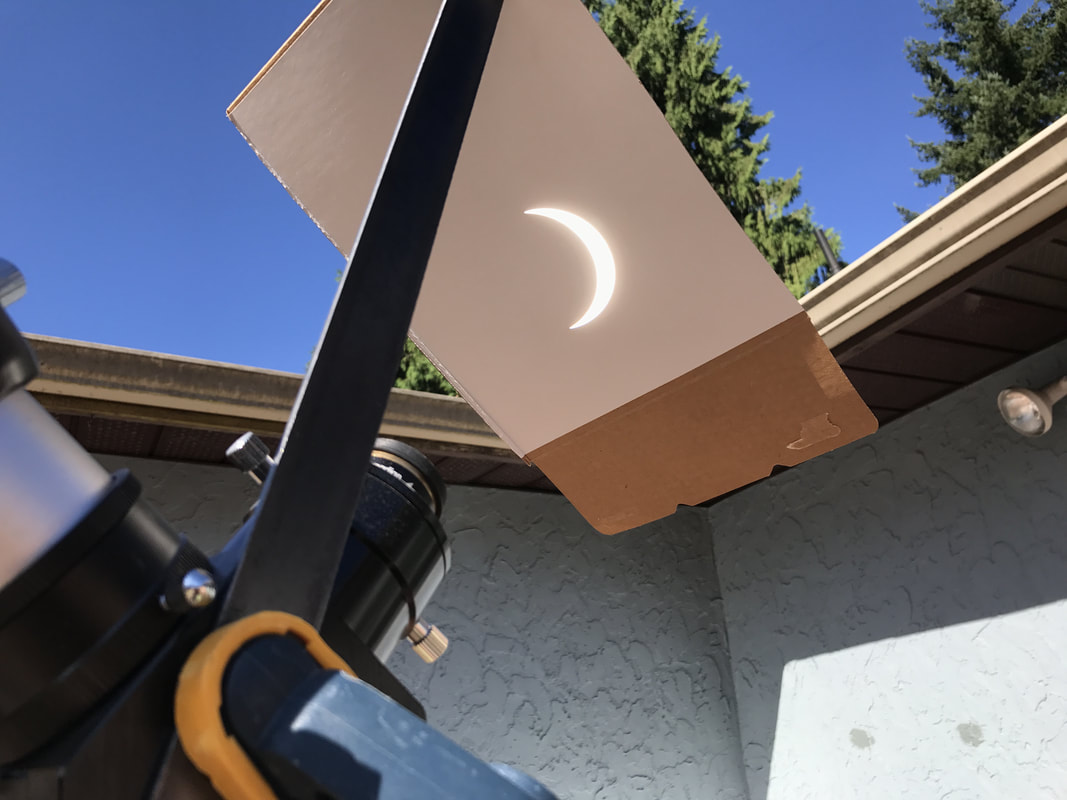|
September 19, 2022
Since Mak designs often have "cool down" issues that impact views due to rapidly changing temperatures inside and outside the optical tube, a recommended method to help with thermal equilibrium issues is to add an inexpensive Reflectix wrap to the tube to insulate it. Here's my pattern and results using a small amount of Reflectix, double sided Velcro tape, and black Gorilla tape to help with any reflections that might impact the view at the meniscus end of the scope as I ran the Reflectix a bit longer than the tube. Note that there is some overlap of the Reflectix wrap, so the Velcro tape on the opposite side isn't right at the edge, test wrap and then place the Velcro tape into position. I tried it out for the first time last night, taking it straight out of the house and started viewing pretty much immediately rather than setting up the scope well in advance for the prerequisite cool down period, and I was pleased with how well it worked. September 5, 2022
Sky-Watcher Skymax 127 AZ-GTi Maksutov-Cassegrain initial experiences Forgive me, this ended up being longer than I intended! The TLDR; version - it's great piece of kit, add the SCT adapter and 2" visual back, and get the V5 SynScan hand controller. I love it, you should buy one too! :-D A quick recap of my astronomy journey so far to set the stage. I started with 7x50 binoculars, soon after got my first scope which was a 6" Orion Starblast table top dob, then a used Celestron C11 on a AS-GT Advanced mount, added a used Celestron C8 Starhopper Dob to the collection, and finally picked up a Celestron C80ED refractor back when Astronomers Without Borders was selling them at blow out/clearance prices, riding on a Vixen Port II mount, all within about 18 months of starting back in the spring of 2012. Over the next few years I gravitated towards using the C8 the most by far, and the C80ED was used almost as often. I found that even with the fantastic views put up by the C11, it was too much trouble and effort to deal with the big, heavy OTA and mount. The 6" Starblast also didn't get used as often anymore since the 8" dob was actually easier to get out and viewing with quickly since it didn't need an extra table or platform to raise the scope up to a seated eye level. Then life got busy, nights at a telescope became few and far between, and before I knew it a couple years passed by and we were in the middle of Covid. I had hardly been out at all, a long lull had set in. During that first year of Covid I decided to sell all my scopes except the C80ED on the Porta II mount. I knew I'd come back to astronomy at some point, but felt pretty confident that my current collection of scopes weren't quite the right ones for me. I consciously kept the C80ED and Porta II as the one most likely to be used when the urge to view struck again. I love dobs, but felt I'd be wanting to go to a bigger 10"-12" dob in the future, and being honest with myself, the C11 was just never going to get used. They all sold pretty quickly to other aspiring astronomers when put up for sale with so many people looking for things to do from home during the early Covid period. Fast forward a few more years to this summer, and I was feeling the pull to get back outside under the stars. I spent many enjoyable nights with the C80ED and starting thinking about what was next. I really enjoy lurking in the Sketching forum, so many amazing drawings of what people are seeing. So I figured I might give that a try. But how to get there? I quickly determined that I don't want to nudge or track manually with slow motion controls while I'm attempting to sketch what I see at the eyepiece. Finding an easy to setup Goto AZ mount with a new 5" to 6" aperture scope that could also carry my C80ED became my goal. The Celeston Nextstar SE6 was on the list, but I didn't think it's single arm fork mount would work with the C80ED's longer OTA. Enter the Sky-Watcher Skymax 127 AZ-GTi. The AZ-GTi mount reviews looked really promising, would work with my refractor, and the Skymax 127 seemed like a nice complementary companion to the C80ED. The 5" Mak (recognizing it actually has an undersized mirror) would give me clean high power views with a reasonable step up in aperture to go along with the lovely wide views of the 3" refractor. The Scope, Mount, and extra Add-ons
I ordered the Skymax 127 AZ-GTi package along with a V5 SynScan hand controller, an Antares SCT adapter for Maksutov-Cassegrain scopes, and a Celestron SCT to 2" visual back. The stand alone Skymax 127 OTA comes with the 2" back, but the one shipped with the AZ-GTi does not, but I still wanted that feature. I ordered the hand controller because I wanted the option to be able to use the scope without needing to use a phone or tablet, and I suspected that I'd prefer the tactile no-look navigating ability with the hand controller over using the need-to-always-look requirement while navigating with a touch screen. (Hint - I was right.) As for the 2" visual back, after reading up on the pros and cons of converting from 1.25" to 2", I decided that regardless of the less that optimal performance where a 2" eyepiece may not be fully illuminated to the edge due to the narrow baffle tube design, as well as introducing a slightly longer focal length which is created by adapting the Mak to use a 2" diagonal, I wanted to be able to use my nice 2" eyepieces anyway. If it really was a poor experience, I'd only be out $50 for the adapter and visual back since I already owned the diagonal. (Hint - going 2" turned out just fine.) Before using any of the hardware or the scope, shortly after unpacking and checking that everything was in order, I upgraded the mount and the V5 SynScan hand controller firmware to the most recent versions. The updates were easy and straight forward to apply using a Windows laptop by connecting over WiFi to update the mount and connecting by USB cable to update the hand controller. I wasn't going to update the firmware right away, but after checking the versions on each of the devices, several updates and improvements had been released since the devices were shipped. I felt it was worth taking the time to perform the update now. Other than a firmware hash check error during the first update attempt of the mount, the updates went smoothly. I Rebooted the mount and restarted the update process a second time which was successful. The hand controller update was quickly completed on the first attempt. Finally I was ready to go outside! The following impressions don't dive into the the optical qualities of the Skymax, C80ED, or the eyepieces and diagonals used, or the mount specifications, there are so many other terrific threads that cover those topics way better than I could. Instead this simply looks at how I felt about using the system as a whole, and how it fit with my observing style and expectations. Night 1
Using the Sky-Watcher Skymax AZ-GTi with firmware updates but otherwise "out of the box" in stock form with the 1.25" diagonal using a 32mm plossl, 66° EWAs, and iPhone SynScan Pro app for mount control. I set up the mount and scope out in the yard fairly early in the evening, got everything oriented set to the North and the mount levelled. The bubble levels on the mount and the iPhone compass app made this quick and easy*. According to the manual, true North rather than magnetic North is the correct orientation, but from reading on the forums it's not so essential as the alignment process would correct for any errors so I didn't bother looking up the True North adjustment and didn't worry about the offset, I simply used magnetic North as my initial home position. The Skymax in 1.25" mode while using a very light 32mm plossl and 66° EWAs was easy to balance on the mount, and being able to release the clutches made quick work of the orientation, levelling, and balancing process. Once I powered on the mount and connected with the SynScan app from my iPhone, the Level North alignment procedure was quick and easy using the red dot finder and 32mm plossl. I had no trouble getting objects into view. The goto functions and navigation using the app was easy and accurate. It was awkward to have to take my eye away from the eyepiece to look at the iPhone screen whenever I was centering an object or when I wanted to pan around the area. The touch screen and SynScan Pro app worked fine as a controller, but being disconnected from the view while changing directions or losing track of my thumb location and the screen controls weren't the best experience. The 32mm plossl and EWA eyepieces put up nice views in the Skymax and I spent about 2 hours viewing Cygnus, M11, and Saturn. Even the 20mm EWA, having the worst flaws of the 66° EWA collection, did well in the long focal length Mak. Seeing wasn't the best so by the time I was testing with the 6mm EWA at 256x magnification, finding best focus was a bit tricky since there's no fine focus knob to make micro adjustments. Trying the clothes pin trick to add additional fine control to the focuser knob might help me nail down the sweet spot in the future. All in all, I was very happy with the experience on the first night and was looking forward to trying out the SynScan hand controller next. * I found during earlier WiFi connection testing that my iPhone would occasionally lose it's connection with the mount WiFi network and auto-connect back to my home WiFi network. The network connection would flip back and forth between them from time to time so I'd lose control of the mount. Disabling the Auto-Connect option on my home WiFi network in the iPhone WiFi networks settings, and leaving it on for the mount network, fixed this issue. Once I'm done using the mount for the evening, I then turn the auto-connect setting back on for my home network. Night 2
Using the Sky-Watcher Skymax AZ-GTi in stock form with the 1.25" diagonal using a 32mm plossl, 66° EWAs, and SynScan hand controller. The 2nd night out was essentially a repeat of Night 1 except this time I used the SynScan hand controller. Using the Brightest Star alignment procedure was also quick and easy after I corrected a few user caused Initialization and Setup mistakes. I found that the initial alignments were off by much more than expected so went back to figure out if I had done something wrong. My first mistake as entering the incorrect year, 2020 rather than 2022. I don't know where my brain went on that one! *facepalm* The second mistake was when I entered the timezone, I used the current Day Light Savings time offset of -7 rather than Standard Daylight time offset of -8, the error was then compounded when I selected Yes to the handset setup question if it was currently Daylight Savings time which set the final timezone value to -6. This is where the iPhone app is really nice, all the initialization and setup is taken care of automatically. Once I sorted all that out, everything went well. I really preferred using the hand controller for aligning and scanning. Keeping my eye at the eyepiece is just so nice compared to always having to take my eye away to use the touch screen. Scanning around Cygnus was a lovely experience with the hand controller and I quickly became accustomed to blindly navigating using the controller with my eye at the eyepiece. Night 3
Using the Sky-Watcher Skymax AZ-GTi converted to use a 2" diagonal using an 82° Astro-Tech 28mm UWA, 70° Olivon 22mm WA, and SynScan hand controller. On the 3rd night I was back to explore the same areas of Cygnus, Saturn, and M11 as the first 2 nights using just the 2" setup: the SCT adapter, 2" visual back and diagonal with my new 82° Astro-Tech 28mm UWA and 70° Olivon 22mm WA eyepieces. This kit setup is certainly heavier than in stock form, and although I don't have a scale to measure, I'm sure is right around the mount's capacity limits. The OTA needed a fairly far shift forward in the balance point to work with the 2" diagonal and hand grenade sized AT-28mm UWA. How would the mount handle the weight and how did it perform with the 2" adaptations? Right away, I was so glad I decided to try the 2" conversion. The mount slewed and tracked just fine, there wasn't any real noticeable difference in vibrations, and there were no focus issues or performance concerns the *I* could detect at the eyepiece. The views through the 28mm and 22mm WA eyepieces were just really, really nice in the Skymax 127, and the experience was so immersive. Cygnus, Saturn, and M11 viewed through this 2" setup with WA eyepieces looked fantastic and is easily my preferred mode over using the 32mm and 20mm 1.25" stock setup. If you already have a 2" diagonal and some nice WA 2" eyepieces, in real practical use, there's no reason in my mind not to have the option to use them with a 127mm Mak on the AZ-GTi mount considering the small $50 additional investment. If you don't already have a 2" diagonal and eyepieces, investing in a nice 24mm 68° WA 1.25" eyepiece instead likely makes the most sense in that scenario. Night 4
Using the C80ED AZ-GTi with SynScan hand controller with a 2" diagonal using an 82° Astro-Tech 28mm UWA, 70° Olivon 22mm WA, 66° EWAs, and SynScan hand controller. The AZ-GTi carried the C80ED with ease. Again sweeping Cygnus is brilliant, M11 and Saturn were easy to aquire with both putting up lovely views, and for a little something different I spent some extra time with the Double Cluster. The difference between the 3" C80ED and the 5" Mak was definitely noticable when observing M11 at similar magnifications. The light gathering and resolving power improvements inherent in the larger aperature that comes with the 5" Mak showed me that it will be a great companion and was a nice step up in size from the C80ED. I'm looking forward to spending a lot more time comparing the views through each scope. The AZ-GTi mount being able to carry both scopes is fantastic. What did I use as a power source? I put 8 freshly charged NiMH AA batteries into the internal battery pack when I first got the scope and didn't change them over the course of the four 1.5-2 hour sessions. On the last night the scope didn't seem to slew to each location as quickly as before, but I didn't notice any other tracking or performance issues. I pulled the battery pack and checked the charge levels at the end of the night. The batteries were at the end of their useful charge life, registering between 1.23-1.26V. I was planning to use an external power tank after these sessions gave me a sense of how long the internal AA batteries would last. My typical sessions are pretty short at 1-2 hours long and I have a healthy supply of NiMH rechargables, so using AA rechargable batteries with the internal power pack isn't going to be an issue for me. No external power tank also means 1 less item to deal with. Portability of the kit is terrific. I can easily carry the mount with the tripod extended and either of the scopes loaded, in and out of the house 1 handed. The whole package is capbable, light weight, easy to use, and suits my unplanned last minute 1-2 hour obseving sessions really well. All in all, I'm very happy with the entire kit, and am really looking forward to spending more time observing, and trying my hand at sketching using both the Skymax 127 and the C80ED while they ride this nice AZ-GTi mount. July 29, 2022
I haven't been out under the stars too often lately, the hobby has been on the back burner for the past few years but I'm starting to get back out there again. At the beginning of the Covid Pandemic I sold most of my gear:
Lately I've been getting interested in maybe doing some sketching. A goto mount will really help with tracking so that I don't need to manually track while sketching. Astronomy inventory seems to still be impacted by ongoing Covid supply chain issues, so it may be a bit before I find something in the 5" - 6" scope range with a goto mount; something like the Skywatcher AZ-GTi with a 127mm Mak or Celestron Nextstar 6 SE SCT are what I'm thinking about getting. I would like to get another Dob too, I miss the simplicity and the amazing views of larger apertures, so a 10" or 12" Dob may also be in the future to round out what I think would be a nicely balanced set of telescopes:
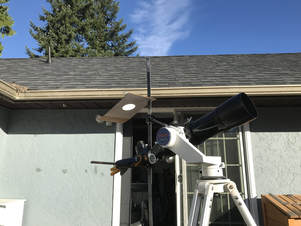
August 21, 2017 - Solar Eclipse Action
My girls joined me for some summer time science, projecting the image with my C80ED. Was a fun event, and we were able to clearly see many sun spots. Our area of the world got to about 80% coverage for the eclipse and we noticed a dimming of the sky and a subtle shift in colour. Very cool! 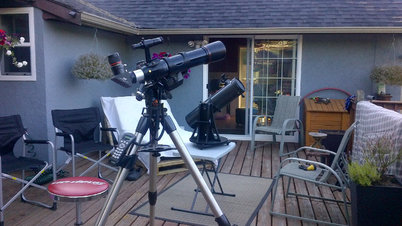
July 26, 2013 - First time with a refractor, C80ED
I'd been considering an 80mm refractor for a few months, but wasn't seriously looking for anything in particular. After following several refractor threads on Cloudy Nights for a few weeks, the Astronomers Without Borders Celestron 80 ED deal for $349 and free shipping was mentioned more than once. I couldn't resist. The scope arrived Monday just as I was leaving for a camping trip so first light happened when I got back home. The C80ED will be riding on my AS-GT mount with the 45 degree diagnol replaced with my 2" GSO dielectric. I'm excited to compare views with my StarBlast 6. ... Just in from a few hours with the C80ED. It was an excellent experience. Beautiful round stars, wide views, split several doubles, nice glimpses of the Ring Nebula, M13 looked good, the Double Cluster was fantastic, the garnet star was super and the details on Luna were sharp. The StarBlast 6 did go deeper, as expected comparing a 3" with a 6" on some of the easier deep space objects I viewed tonight. The extra aperture definitely helped, and even with Luna rising I got more detailed views with the 6". I'm looking forward to darker nights or viewing from a dark site without the moon with the C80ED, this scope gives very nice views. The C80ED rode the AS-GT like a champ. Even on my deck at high magnification, there was basically zero damping time. The rack and pinion focuser handled my lightweight eyepieces, Orion Expanse clones, with ease and focusing was smooth and easy. A rotating focuser would have been nice but otherwise it's fine for a light set of eyepieces and a 2" diagnol. I'm already thinking about an alt-az grab and go mount for it, I'll have to start saving my nickels! If I had to choose between the C80ED and the StarBlast 6, I'd have to take he StarBlast for the aperture. But the C80ED is a keeper, and if I have an alt-az mount, I can see it getting more use than the StarBlast as I often have very quick windows of opportunity, 30 minutes or less. The StarBlast is definitely portable, but requires the extra table and sometimes I just don't feel like making the extra effort. Lazy I know, but there it is! 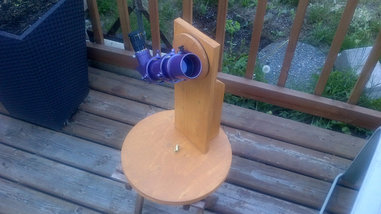
July 21, 2013 - What do you do with your Leftovers?
I had a 50mm finder scope with awful 6 screw alignment. The tube was scratched horribly, and the rubber eye cup had disintegrated. A few quick hours of simple wood work with scraps and left over fence stain, tube sanding, take my 6 year old daughter to pick out new paint colors (metallic purple of course) and viola! A simple 16" alt-az mount with CD bearings, brass wingnut and washer tension adjustments, an unused 26mm plossl that happens to come to focus at the same point in the non-adjustable finder, and what turned out to be a few hours of enjoyable views last night with my girls. This will be coming camping with us next week! June 28, 2013 - A Noob's Journey...
Christmas 2011. I received a terrific gift from my wife, Terence Dickinson's NightWatch. She thought I needed a hobby, something that wasn't related to computers, programming, technology or anything remotely connected to my job. She was right. That book was devoured quickly. I was ready to graduate to viewing with something other than my eyeballs and ordered the inexpensive Orion Scenix 7x50 binocular and found myself out under the poor West Coast winter skies as often as the conditions allowed. I was immediately hooked. After reading Astronomy Hacks and another of Terence Dickinson's books co-written with Alan Dyer, The Back Yard Astronomer's Guide, I was ready to purchase my first telescope. I ordered the Orion StarBlast 6, sans object locator, in the spring of 2012, along with a RACI 9x50 finder, 32mm plossl, 2x barlow, moon and colour filters. The StarBlast 6 appealed to me because of the simple alt-az Dob style mount, portability, aperture size, wide fields and overall value. I spent most of the next year wandering the skies pretty randomly with only the brightest stars, planets and the moon as known targets. I enjoyed every minute of these unplanned evenings scanning purely to "see what I could see." A moon filter is an important tool for for me when viewing the moon. I have eyes that are fairly sensitive to bright light, I squint during the day without sunglasses and the moon has me in tears soon after starting a session...literally! Many people have no issues viewing the moon without a filter, for me it's necessary even with lots of ambient light. After my first telescope purchase, I discovered the online forum Cloudy Nights. It is a terrific and friendly resource for any and all astronomy related topics. I lurked and soaked up the content whenever the evening skies where hidden by typically overcast, rain saturated Western Canadian weather patterns. In other words I was online nightly! I felt good about my first telescope purchase based on general recommendations I noticed on CN. I might have chosen an 8" or 10" Dob to start had I discovered the forums sooner, but hindsight is what it is and my StarBlast 6 is still my most used astronomy tool. Even with another scope recently added to my collection plus others likely on the distant horizon I don't anticipate selling the StarBlast. After being inside since late October in the fall of 2012 through early winter of 2013, I was itching for some new gear. As many can attest to on CN, a typical accompanying symptom of this particular itch is Aperture Fever. I began window shopping the classifieds and online stores for big Dobs and SCTs. CN forum posts recommending 8" to 12" Dobs to new buyers had me wondering what I was missing with my 6". The selection of used equipment on Vancouver Island wasn't promising. After scanning for months I had almost given up on finding a smokin' deal as can often be found in major city centres by the time I factored in ferry costs to pick up items in Vancouver or shipping from the rest of Canada or US. I stumbled across a listing for a StarBright (pre-XLT coatings) C11 SCT on an AS-GT mount in town. The price was a bit higher than I was hoping for although not too far off what can be found in used scope saturated metropolitan areas. Being in town with no shipping fees was a definite bonus, not to mention I could examine the scope in person. The scope was brought home that night. I set it up in the living room, and admired the massive beast that it was. It needed a bit of work: there were a few silky spider webs in the OTA, the corrector was relatively clean but could use a bit of TLC. The mirrors were very nice, no cleaning needed there. The set screw for the focuser knob was missing and the firmware for the AS-GT mount was the original factory release version according to the firmware history on the NexStar Resource Site. The finder was in rough shape and the OTA exterior needed a bit of buffing and cleaning to remove some left over glue from what looked like a Telrad base. So not a pristine beauty, but also not bad and everything looked fixable with a bit of effort and a few more dollars. I probably would have passed this one over had I had more options locally, I'm sure most people in metro areas would have been able to get a lower price, but I'm fine with a project scope as long as the core of the scope is functional. A 14mm 72 degrees Antares Speers-Waler, a 54mm Erfle along with a few plossls made the package a reasonable deal all things considered. I set to work, first creating a patch cable from a surplus CISCO networking console cable and an appropriate 4 pin connector, following the wiring diagrams on the NexStar Resource Site. After downloading the most recent firmware and flashing both the hand controller and the motors I took it for a quick spin with Stellarium. Fantastic! But I determined that laptop astronomy isn't for me, at least not now. Slewing and Goto with the hand controller was accurate and simple enough that the laptop felt redundant and was just extra gear to lug around. I spent the next few sessions getting familiar with the scope, polar aligning and getting acquainted with the current state of the optics. Next I removed and cleaned the corrector following various recommendations found on CN forum posts. I also discovered that the corrector had been rotated out of position as well as the secondary mirror housing would spin independently of the corrector itself. Rough pre/post star tests show an improvement after fixing the rotation positioning using the etched serial number on the corrector and secondary housing serial number/screw orientation recommendations posted in various threads on the CN forums. Collimation was a bear with the hex screws, so those were replaced with Bob's Knobs. I much prefer using them, but I've made sure to keep the originals as many CNers commented that they preferred those in the long run. For now, Bob's Knobs have kept me sane while learning to collimate the C11. I haven't had any great viewing opportunities to validate collimation at very high powers, but my inexperienced eye finds the medium and low power views to be good. Globular clusters just pop! Clear skies will give me an opportunity to fine tune as needed. I couldn't find an appropriate focuser knob set screw that wouldn't slip in my random collection of screws, so I drilled a pilot hole and used a computer motherboard screw to self tap threads in the brass knob assembly. I holds nicely now. After several night out, I can feel that the grease on the baffle isn't as smooth as it should be after running the mirror up and down the entire range of the baffle a dozen times. I suspect I'll need to clean it off and reapply something appropriate to improve the ride and tighten up the modest amount of mirror flop that's present. I didn't like the lack of fine focus with the stock C11 focuser. I found an external Crayford GSO SCT focuser in my price range and figured it was worth a try. I added a 2" dielectric star diagnol to the list and ordered an Orion compatible SCT finder base as well. The original finder was in pretty rough shape and I hate doing alignment with 6 screws instead of 2, so getting another base to mount my RACI made sense. The first night out with the new gear was awesome! The external focuser with 10:1 reduction that can rotate plus adding the RACI finder made the experience so much more enjoyable. I love it! I also got Bob's Knobs for the StarBlast 6 and added milk jug washers to the secondary. These style knobs and washers should be installed at factory. There's no excuse to not have them as standard equipment on all Dobs, they improve the collimation experience so much. I can't get high enough magnification on the StarBlast due to the perpetually swimming skies to ensure best collimation, but that stars are pleasing and deep sky objects look great to me. I added a 9x50 straight through finder to the StarBlast 6 as I was starting to get into star hopping and aiming the scope wasn't very accurate using the RACI or sighting down the length of the tube. But in the end I found the neck and head contortions going from the eyepiece to the straight through finder uncomfortable. The straight through went onto the C11 where it works great and the original red dot finder made initial aiming of the StarBlast in my orange skies easier than using the RACI. Now I do initial targeting with the RDF and then it's swapped out for the RACI if a low power eyepiece isn't wide enough to hop to the next step. I'll order another finder base or add a Rigel Quick Finder giving me both a zero power finder and the RACI on the tube full time, the best of both worlds. With the poor weather continuing into the first days of summer, I've been out only a few times, for short sessions lately. This is were I love the StarBlast as it's quick and easy to set up on a little portable table, gives me fantastic views and is put away just as quickly. I added a set of 66 degree Orion Expanse eyepiece clones: 6mm, 9mm, 15mm, 20mm. I was looking for more eye relief at high powers and wider views but didn't want to spend a lot of money. A modest improvement in eye relief comfort and a wider field of view were my goals. I went back and forth between spending more on Baader 68 deg Hyperions or ES 82 deg eyepieces, but held back as I wanted to see for myself how the 66 deg low cost eyepieces performed. The reviews I read online were favorable towards the high powered pieces and but less complimentary of the 15mm mid power and sometimes harsh on the 20mm low power piece. I knew going in that they weren't able to compete with the Hyperion or ES eyepieces so I set my expectations accordingly. The low power 20mm eyepiece does break down a fair amount on the outer 30% in the StarBlast as warned in reviews when pairing it with a fast scope, but is not so different from my 25mm and 32mm plossls at the edges. It's roughly comparable to my plossls while giving a wider field of view at higher magnification. I find it to be just fine in the C11. The 15mm is currently my most used eyepiece, being much lighter than my 72 deg 14mm Antares. The 9mm and 6mm look great on the moon but I haven't used them as much as the 15mm due to poor seeing conditions. All in all I think they're a good overall value for minimal investment and wouldn't hesitate to recommend them to a budget conscious buyer who is looking to take a step beyond their standard plossls. In particular, definitely invest in the 15mm, 9mm and 6mm for the wide views and good eye relief. If you have a 25mm plossl already plus a fast scope you can skip the 20mm 66 deg eyepiece. If you have a SCT or a Mak they will perform very well with the F10 or longer scopes. In the end I'm pleased with these eyepieces, modest improvements for a nice price. I think they will serve me well. I've been spending more time with star charts, atlases, and learning to star hop. There are many free atlases that gave me my start such as the Mag-7 Atlas Project, the TriAtlas, Deep-Sky Hunter Atlas and Taki's Atlases. A person could go a long ways with just those resources and I still use them after purchasing other materials. I picked up Pocket Sky Atlas, Cambridge Star Atlas, Objects in the Heavens, Turn Left at Orion and Deep-Sky Wonders over the past few months. I use and refer to all of them. At the scope I spend most of my time with a monthly star chart from SkyMaps.com and Objects in the Heavens. The SkyMap orients the sky nicely for me and OITH is an excellent field guide of objects, has a short description of what the objects are and has enough content to keep me occupied in a constellation for hours. I can spend the night in just one or two constellations fully content to hop around the local area, supplementing OITH with PSA when I want more detail on the surrounding star fields. A red nail polish painted LED flashlight comes in super handy here! I've tried iPhone and iPad atlas/planetarium apps along with a laptop at the telescope, but it's not for me. I prefer paper charts and coil backed/lay flat books. For computer software Stellarium is wonderful inside the house providing an emersive 3D environment plus has the ability to control ASCOM compatible mounts and has an ocular feature where you can setup your scope and eyepieces to simulate your views. Cartes du Ciel enables detailed study, printing custom charts to take out to the scope and can also control your mount. I definitely lean towards the minimalist side at the scope, appreciating the go-to on my AS-GT but I'm not looking for anything more high tech for charting/finding objects. It's paper for me! I must comment on Turn Left at Orion, drawing attention to the authors recommendation to never clean your eyepieces. I was actually very surprised by this, considering all the commentary I've read elsewhere on this topic. This statement by the authors is not even remotely realistic! Obviously take care when cleaning, but to never clean your eyepieces is a crazy recommendation. They do concede that if you must clean your eyepieces do it rarely. The way they address the topic gives me the impression that they feel that cleaning can be avoided altogether. I am cursed with long eye lashes, and the oils eventually end up on every eyepiece that I own. High power plossls with short eye relief such as a 10mm require cleaning after every session otherwise I'd be looking through a filmy oil slick after just a few viewings! Longer eye relief lenses last several sessions between cleaning, but to recommend I avoid cleaning completely or to imply some world ending cataclysm will occur if I do clean them? Nonsense! If you ever hand this book on to somebody, the section should be redacted so an unknowing recipient doesn't think eyepieces are delicate flowers that must be treated in a vacuum chamber and remain untouched by mere mortals. Don't take steel wool to it when cleaning but do carefully remove foreign debris and oils with air-puffers, non-abrasive pure cotton balls, Q-tips or other similar solutions. Otherwise, I love this book, it helped me realize I had in fact located many objects I'm looking for after passing them by dozens of times. I had no real point of reference for what each object looked like other than the typical glossy high resolution images found all over the web. The faint and dusty objects or sparse collections of stars in an open cluster are what I'd pass over without realizing they're exactly the objects I've been spinning my wheels trying to find! Very helpful! Deep-Sky Wonders takes a similar descriptive approach to finding objects, but provides glossy images to go with star charts. Now that I'm more familiar with the "real" views I can expect at the eyepiece, I'm not thrown off so much by the photos and enjoy the book a lot. I'm looking forward to the nights getting longer again as summer leads into fall, which will allow me to spend more time with the C11. I have enjoyed using it the half dozen times I've managed to get it out since my tweaks. The late sunsets and poor weather lately does mean the C11 is not on my mind when I go out and setup for short 1 hour sessions. The OTA and mount are big, a bit awkward and a homemade dew shield is mandatory nearly every night in my climate, but goto and the high powered views of globular clusters and galaxies are so enticing that what I've seen so far leaves me wanting more. I'm really looking forward to longer nights with good transparency and seeing! Next on the agenda, besides simply waiting out the bad weather and getting some time at the eyepiece, is to tackle replacing the lube on the C11 baffle and possibly replacing the stock StarBlast 6 plastic rack and pinion focuser with a GSO 2" Crayford 10:1. I'd like some more fine focus control and remove the minor eye piece slop in the stock focuser. The GSO focuser offers a spacer for the 6" OTA, and with a bit of drilling and grinding out the original draw tube hole it should be a straight forward upgrade. I don't really want to replace the whole OTA with another that already includes a better focuser even though the cost of the GSO focuser alone might make that a reasonable choice. I like the current tube and optics, and for a small investment I think I will have something that will last me for ages. Beside, a 12" Dob would be my next desired scope purchase, not another 6" reflector...or maybe a 8" EdgeHD...or a 150mm Mak...an 80mm Apo...how about a 190mm MakNewt... Clear Skies! |
Stores & Websites
Agena Astro Astro Buy Sell Astronomers Without Borders Astronomics Clear Outside Clear Sky Chart Cloudy Nights Free Astro Magazine Light Pollution Map NexStar Resource Site Orion Telescopes & Binoculars RASC Journal Telescopes Canada Free Atlases & Charts Atlas of the Sky Deep-Sky Hunter Star Atlas Deep Sky Surfing Atlas Discovering Astronomy IAU - The Constellations Mag-7 Atlas Project Sky Atlas 2020 Sky Maps Taki's Atlases TriAtlas Project TriAtlas Project (Mirror) Books Astronomy Hacks - hacks is an odd name, but a great collection of tips, tools, and knowledge that is otherwise strewn about various online forums; contains lots of useful info in howto styled topics. Back Yard Astronomer's Guide - takes Nightwatch to the next level, the best all around astronomy book available. Cambridge Photographic Star Atlas - designed as lovely double spread layout photographic and chart atlas. Cambridge Star Atlas - a nice and comfortably scaled star atlas, may not go deep enough for difficult areas or objects but I enjoy using it. Deep-Sky Companions - a great series of books by Stephen O'Meara; The Messier Objects, Caldwell Objects, Hidden Treasures, Southern Gems, Herschel 400, The Secret Deep. Deep Sky Wonders - collection of targets and how to find them with full colour images; bite size articles collected from S&T's Sue French articles. Interstellarum Deep Sky Atlas - a beautiful and detailed atlas which uses an innovative method of identifying the visibility of objects in different sized aperatures. NightWatch - recommended first book for everyone; essential overview for anyone new: general astronomy, telescopes, viewing, and more. Objects in the Heavens - an essential field guide, tells me what the various objects are and where to find them by constellation. Pocket Sky Atlas - recommended first atlas and perfectly sized for use at the scope Turn Left at Orion - recommended first object viewing book for everyone; gives fantastic star hopping instructions and sketches of what to realistically see at the eye piece. Software Cartes du Ciel Stellarium |

